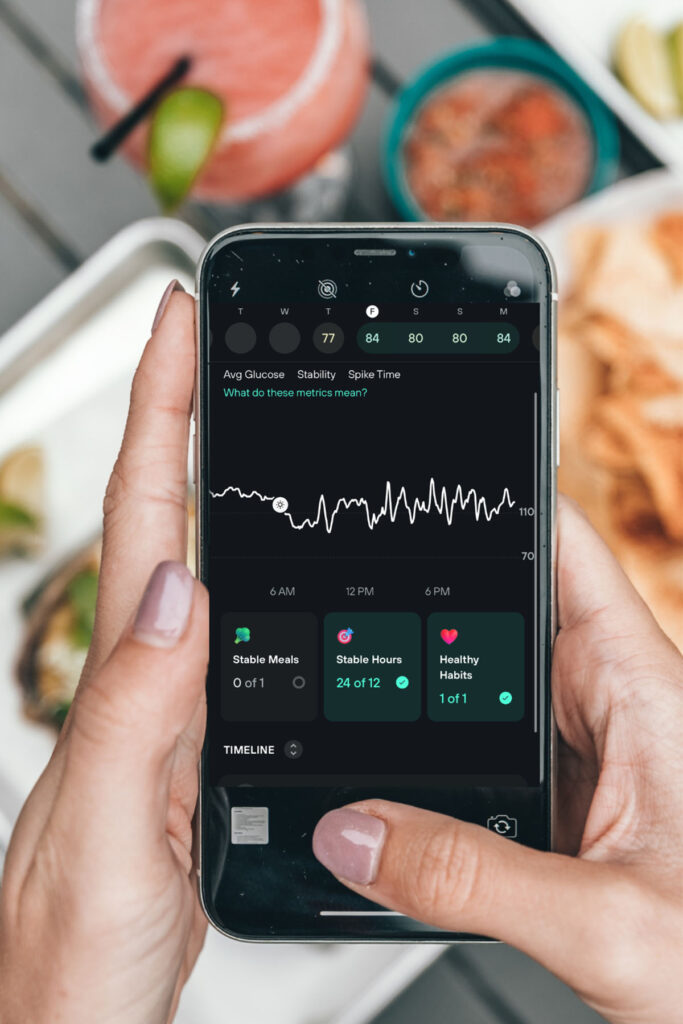
Doctor-Backed Tips to Lower Blood Glucose: Insights from Dr. Casey Means
Managing blood sugar is not a new conversation, but it is worth having, especially considering the health benefits you could experience by learning how to lower blood sugar levels. Common thought has been to eliminate sugar and restrict all carbs, but blood sugar management is more than just a food problem. It’s a lifestyle.
I interviewed Dr. Casey Means co-founder of Levels and author of Good Energy, on the podcast to discuss blood sugar regulation and what she has learned since co-founding the company Levels. Levels provide an easy-to-use app connected to a continuous blood glucose monitor to give you results in real time.
I took it for a test run and was shocked by the results. Inside the podcast, I ask Dr. Casey Means about the diet and lifestyle recommendations she has found to be the most successful in regulating blood glucose levels. I was surprised to hear her number one tip had nothing to do with food.
Why blood glucose matters to your health
Blood glucose levels naturally rise and fall throughout the day. This is called glucose variability. The degree to which they do is an excellent indicator of overall metabolic health. Metabolic health is the tool that determines energy flow.
If your blood glucose level has too many spikes and valleys, that can indicate metabolic dysfunction.
Metabolic dysfunction is a slowing of energy flow and production linked with numerous illnesses and diseases. Some of the big hitters are cancer, dementia, and cardiovascular disease. But before those become a problem, you’ll often find it starts with inflammation, increased hunger, cravings, interference with your natural rhythms, and an increase in negative emotions.
As Dr. Casey Means mentioned in the podcast, like all things related to health, your blood glucose levels determine more than a biological reaction but a mental and emotional one.
Of course, metabolic dysfunction doesn’t happen because of one meal in one day. It’s what you do consistently over time that shifts how your body responds.
Regulating your blood glucose levels
Formerly, tracking how your body responds to the foods you consume and your lifestyle has been challenging. Outside of a feeling, how do you know? Of course, blood levels can give some indication. But many of those values are a quick snapshot showing your levels when it was drawn, not over time.
But with a new program like Levels, you can see your system’s continuous stream of glucose in real time. These levels help you to track how your body responds to every meal, every sleep cycle, every stress, and every workout.
In the process, you can understand patterns, consistencies, and problems associated with your blood sugar. Plus, you can analyze how beneficial your changes are in regulating the peaks and valleys.
The goal is not to take away completely the peaks and valleys. These are necessary for homeostatic control. But the goal is to keep your blood sugar highs and lows looking like rolling hills rather than mountaintops and valleys.
It’s to have a more consistent and even flow that keeps the system in a homoeostatic balance, not throwing it completely out of whack.
Dr. Casey Means Tips To Regulate Blood Glucose
I have taken the levels CGM for a spin the last few months and found immense value. I was also shocked by some of the results and discussed them with Dr. Means on the show. Of course, we talked about food and sleep, but Dr. Means shared that consistent movement throughout the day is one of the best ways to regulate blood glucose levels.
Dr. Means recommended bouts of one to two minutes of movement every hour, stating it significantly impacted glucose levels. Even more so than a strenuous 30-minute or one-hour workout once a day.
I loved this advice. Partially because it’s so practical, we can all take the time to stand up every hour and move for two minutes. But it also debunks the idea that only hard, strenuous workouts every day will change you.
That’s not to say that isn’t healthy. But as she talks about in the podcast, working out once a day and then sitting for most of it is not nearly as healthy as consistent movement, even without a workout at all.
It’s so easy to get hung up in all of the diet advice telling us what we should and shouldn’t do that we miss the element of everyday life. The advice states you need to move more. Even if it’s in the smallest increments, done more consistently is all it takes to get healthier.
We don’t have to overcomplicate it but make small shifts. And those small shifts pay off significantly, like helping you regulate your blood glucose levels, making you feel better and more energized overall.
Are you up for the challenge?
Try it out for yourself.
Set an alarm on your phone to go off at the top of every hour. Then, commit to standing up and moving around. That could be a little walk outside or through the office. If you’re at home, you could do some laundry or pick up a small area of your living space.
It doesn’t matter what it is, but take the challenge to move for two to five minutes at the top of every hour and see how you feel.
Other ways to level up your blood glucose.
Of course, you can make small practical changes to up-level your glucose levels in many other ways. These are some of the best glucose-regulating practices I have found since learning my results from testing out Levels.
01. Eat a healthy protein and fat at every meal.
I’m not denying carbs aren’t necessary. They can and should be a part of a healthy diet. But carbs alone are not nearly as beneficial to your body as when eaten in a meal with healthy sources of protein and fat. Protein and fat are harder to digest and don’t have the same glucose spike. Instead, they slow it down, helping to regulate glucose levels so your body doesn’t have to fight so hard.
Eat more meals and fewer snacks. Whenever you eat, add protein and fat.
02. Move after eating.
Movement after food increases the rate at which you can burn through the glucose and use it rather than your body fighting to process and store it. It up-regulates your need for energy and, over time, prevents the glucose spikes, even if you ate a lot of glucose in a meal.
Plan a burst of movement after meals as often as you can. Go for a walk or do some chores. It will make a difference in how you use the glucose.
03. Eat earlier in the day (avoid late-night snacking).
Research on circadian rhythms has found an ebb and flow to your metabolism, insulin sensitivity, and gastric enzymes, helping you digest and absorb food based on your sleep cycles. They have found all of these things happen to be at the highest earlier in the day and decrease as the day turns into night.
That is why you will find more glucose control by eating earlier in the day. I did an experiment that proved this. I ate the exact same meal on the same day. The first meal was at 11:30 a.m., and the second was at 6:30 p.m. There was no spike with the first meal, but over a 45-point jump in eating the same meal later in the day. This proves the power of circadian fasting and how important meal timing is, regardless of what you eat.
04. Get enough sleep.
Considering your circadian rhythm has such power over your hormones and glucose levels, it’s no surprise how well you sleep changes how your body responds. If you want to get healthy, you must prioritize sleep.
05. Regulate your nervous system.
Unsurprisingly, stress will boost your blood glucose levels, even without food. The stress response pulls stored glucose to beat the stress, making glucose available even without food.
In the short term, this is a necessary, even life-saving practice. But you can see why prolonged stress can wreak havoc on your body, with a constant flood of unnecessary and even damaging glucose to the system. In time, this leads to insulin resistance.
But it’s not always the stress that’s bad. It’s the lack of regulation within the stress. Instead of fighting stress, learn how to regulate your nervous system regardless of it. Self-regulation helps maintain a sense of balance inside the body.
Try it out for yourself.
Not many tools you can use that give you results in real time. Even blood work is a quick snapshot of the moment, not the long haul. But Levels has changed that. It provides continuous data, tracked every second and delivered right to your phone.
It shows real results in real time. You’ll get a picture of how your body responds as soon as you eat that meal. When you know, you can do something to shift it.
I recommend Levels for anyone interested in taking their health up a notch. Grab your Levels kit here.
**If you purchase a Levels device, shoot me an e-mail, and I would be happy to offer you e-mail support as you use it.
*GIVEAWAY*
Sign up to win a free year of Levels app and one month of glucose monitors. The giveaway is only open for a limited time.
Want to learn more about Dr. Casey Means?
Here are a few additional resources I pulled together to improve your learning.
- Levels Blog
- Dr. Casey Means Instagram
- The Essential Guide To How Much Protein You Need + What 130 Grams Looks Like
- The Dos and Don’ts of Metabolic Eating
- Shifting Your Perspective on Health
- Tired? Here’s How To Get More Energy
